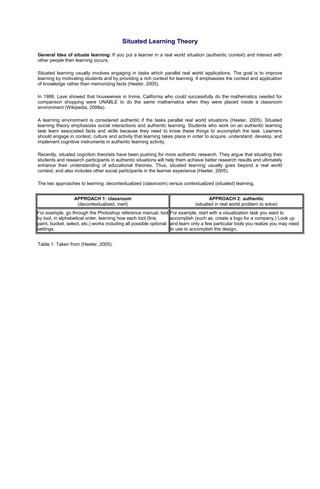Situated learning theory
•Descargar como DOC, PDF•
2 recomendaciones•2,947 vistas
Situated learning theory proposes that learning is most effective when it occurs in an authentic context that mirrors real-world situations and involves social interaction. According to the theory, placing learners in realistic environments and having them engage with other people on meaningful tasks enhances motivation and provides a richer context for learning compared to traditional classroom settings. The theory emphasizes learning through authentic activities rather than via memorization of facts.
Denunciar
Compartir
Denunciar
Compartir

Recomendados
Más contenido relacionado
La actualidad más candente
La actualidad más candente (20)
Scaffolding instruction using the workshop model in pbl

Scaffolding instruction using the workshop model in pbl
Chapter 5: Learning theories related to educationa Technology

Chapter 5: Learning theories related to educationa Technology
Similar a Situated learning theory
This faciliated conversation explores Arts students’ responses to using ePortfolio for enhancing their learning acorss a range of degree programs at four universities in Australia. This multi modal approach to data collection is the result of the recent outcomes of on an OLT funded project that aimed to introduce ePortfolios to students undertaking degree programs in the creative and performing arts. The project to date has identified that knowledge management is a key factor for students as they progress through the process of ePortfolio development. The project’s outcomes are to provide tertiary students from the Performing and Creative Arts with skills to create an ePortfolio to document their academic and artistic outcomes for future employment and enhanced employability in the arts sector. What has appeared is that the artisitc identity of the students is forming through the process of reflection “on” and “in” their various degree programs’ discreet subjects.Technology, learning and identity: rethinking ePortfolios for Arts students’...

Technology, learning and identity: rethinking ePortfolios for Arts students’...ePortfolios Australia
Similar a Situated learning theory (20)
teaching_everyday_practice_communities_of_practice

teaching_everyday_practice_communities_of_practice
Technology, learning and identity: rethinking ePortfolios for Arts students’...

Technology, learning and identity: rethinking ePortfolios for Arts students’...
A Term Paper for the Course of Theories and Approaches in Language Teaching(...

A Term Paper for the Course of Theories and Approaches in Language Teaching(...
Situated learning theory
- 1. Situated Learning Theory General Idea of situate learning: If you put a learner in a real world situation (authentic context) and interact with other people then learning occurs. Situated learning usually involves engaging in tasks which parallel real world applications. The goal is to improve learning by motivating students and by providing a rich context for learning. It emphasizes the context and application of knowledge rather than memorizing facts (Heeter, 2005). In 1988, Lave showed that housewives in Irvine, California who could successfully do the mathematics needed for comparison shopping were UNABLE to do the same mathematics when they were placed inside a classroom environment (Wikipedia, 2008a). A learning environment is considered authentic if the tasks parallel real world situations (Heeter, 2005). Situated learning theory emphasizes social interactions and authentic learning. Students who work on an authentic learning task learn associated facts and skills because they need to know these things to accomplish the task. Learners should engage in context, culture and activity that learning takes place in order to acquire, understand, develop, and implement cognitive instruments in authentic learning activity. Recently, situated cognition theorists have been pushing for more authentic research. They argue that situating their students and research participants in authentic situations will help them achieve better research results and ultimately enhance their understanding of educational theories. Thus, situated learning usually goes beyond a real world context, and also includes other social participants in the learner experience (Heeter, 2005). The two approaches to learning: decontextualized (classroom) versus contextualized (situated) learning. APPROACH 1: classroom APPROACH 2: authentic (decontextualized, inert) (situated in real world problem to solve) For example, go through the Photoshop reference manual, tool For example, start with a visualization task you want to by tool, in alphabetical order, learning how each tool (line, accomplish (such as, create a logo for a company.) Look up paint, bucket, select, etc.) works including all possible optional and learn only a few particular tools you realize you may need settings. to use to accomplish the design. Table 1: Taken from (Heeter, 2005).